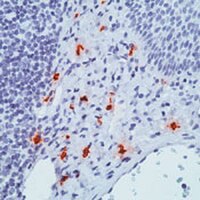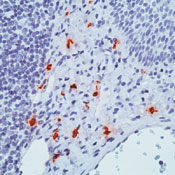444905 Sigma-AldrichAnti-Mast Cell Tryptase Mouse mAb (AA1)
This Anti-Mast Cell Tryptase Mouse mAb (AA1) is validated for use in Frozen Sections, Immunoblotting, Paraffin Sections for the detection of Mast Cell Tryptase.
More>> This Anti-Mast Cell Tryptase Mouse mAb (AA1) is validated for use in Frozen Sections, Immunoblotting, Paraffin Sections for the detection of Mast Cell Tryptase. Less<<Recommended Products
개요
| Replacement Information |
|---|
주요 사양표
| Species Reactivity | Host | Antibody Type |
|---|---|---|
| Ca, Fe, H, Mk | M | Monoclonal Antibody |
가격 및 재고여부
| 카탈로그 번호 | 재고 정보 | 패킹 | 포장 단위 | 가격(VAT 별도) | 수량 | |
|---|---|---|---|---|---|---|
| 444905-100UGCN |
|
Plastic ampoule | 100 μg |
|
— |
| Product Information | |
|---|---|
| Form | Liquid |
| Formulation | In 10 mM PBS, pH 7.4. |
| Positive control | Cat, dog, human, or monkey mast cells |
| Preservative | None |
| Quality Level | MQ100 |
| Physicochemical Information |
|---|
| Dimensions |
|---|
| Materials Information |
|---|
| Toxicological Information |
|---|
| Safety Information according to GHS |
|---|
| Safety Information |
|---|
| Product Usage Statements |
|---|
| Packaging Information |
|---|
| Transport Information |
|---|
| Supplemental Information |
|---|
| Specifications |
|---|
| Global Trade Item Number | |
|---|---|
| 카탈로그 번호 | GTIN |
| 444905-100UGCN | 04055977186208 |
Documentation
Anti-Mast Cell Tryptase Mouse mAb (AA1) MSDS
| 타이틀 |
|---|
Anti-Mast Cell Tryptase Mouse mAb (AA1) Certificates of Analysis
| Title | Lot Number |
|---|---|
| 444905 |
References
| 참고문헌 보기 |
|---|
| Sommerhoff, C.P., et al. 2000. Biochim. Biophys. Acta.1477, 75. Little, S.S., and Johnson, D.A. 1995. Biochem. J. 307, 341. Morgan, S.J., et al. 1991. J. Allergy Clin. Immunol. 87, 111. Walls, A.F., et al. 1990. J. Pathol. 162, 119. Wall, A.F., et al. 1990. Clin. Exp. Allergy 20, 581. |















